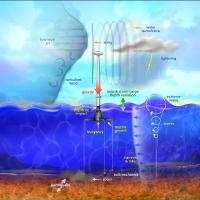 |
OpenFAST
Wind turbine multiphysics simulator
|
 |
OpenFAST
Wind turbine multiphysics simulator
|
This function compares two real numbers and determines if they are "almost" equal, i.e. More...
Public Member Functions | |
| logical function | equalrealnos4 (ReNum1, ReNum2) |
| This function compares two real numbers and determines if they are "almost" equal, i.e. More... | |
| logical function | equalrealnos8 (ReNum1, ReNum2) |
| This function compares two real numbers and determines if they are "almost" equal, i.e. More... | |
| logical function | equalrealnos16 (ReNum1, ReNum2) |
| This function compares two real numbers and determines if they are "almost" equal, i.e. More... | |
This function compares two real numbers and determines if they are "almost" equal, i.e.
within some relative tolerance (basically ignoring the last 2 significant digits) (see "Safe Comparisons" suggestion from http://www.lahey.com/float.htm)
Note that the numbers are added together in this routine, so overflow can result if comparing two "huge" numbers.
Use EqualRealNos (nwtc_num::equalrealnos) instead of directly calling a specific routine in the generic interface.
| [in] | renum1 | the first real number to compare |
| [in] | renum2 | the second real number to compare |
| logical function nwtc_num::equalrealnos::equalrealnos16 | ( | real(quki), intent(in) | ReNum1, |
| real(quki), intent(in) | ReNum2 | ||
| ) |
This function compares two real numbers and determines if they are "almost" equal, i.e.
within some relative tolerance (basically ignoring the last 2 significant digits) (see "Safe Comparisons" suggestion from http://www.lahey.com/float.htm)
Note that the numbers are added together in this routine, so overflow can result if comparing two "huge" numbers.
Use EqualRealNos (nwtc_num::equalrealnos) instead of directly calling a specific routine in the generic interface.
| [in] | renum1 | the first real number to compare |
| [in] | renum2 | the second real number to compare |
| logical function nwtc_num::equalrealnos::equalrealnos4 | ( | real(siki), intent(in) | ReNum1, |
| real(siki), intent(in) | ReNum2 | ||
| ) |
This function compares two real numbers and determines if they are "almost" equal, i.e.
within some relative tolerance (basically ignoring the last 2 significant digits) (see "Safe Comparisons" suggestion from http://www.lahey.com/float.htm)
Note that the numbers are added together in this routine, so overflow can result if comparing two "huge" numbers.
Use EqualRealNos (nwtc_num::equalrealnos) instead of directly calling a specific routine in the generic interface.
| [in] | renum1 | the first real number to compare |
| [in] | renum2 | the second real number to compare |
| logical function nwtc_num::equalrealnos::equalrealnos8 | ( | real(r8ki), intent(in) | ReNum1, |
| real(r8ki), intent(in) | ReNum2 | ||
| ) |
This function compares two real numbers and determines if they are "almost" equal, i.e.
within some relative tolerance (basically ignoring the last 2 significant digits) (see "Safe Comparisons" suggestion from http://www.lahey.com/float.htm)
Note that the numbers are added together in this routine, so overflow can result if comparing two "huge" numbers.
Use EqualRealNos (nwtc_num::equalrealnos) instead of directly calling a specific routine in the generic interface.
| [in] | renum1 | the first real number to compare |
| [in] | renum2 | the second real number to compare |
 1.8.13
1.8.13